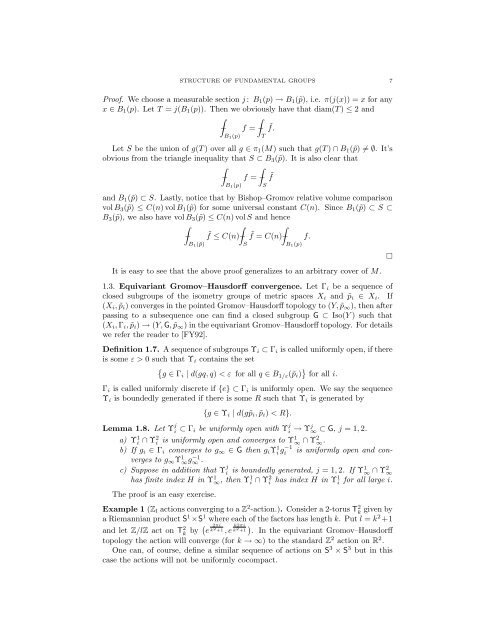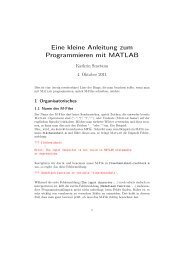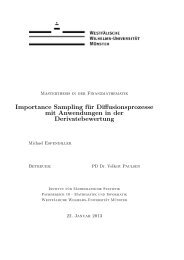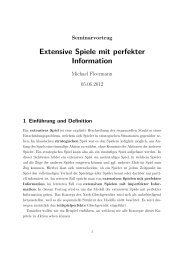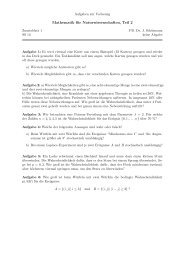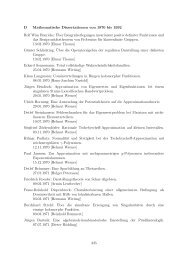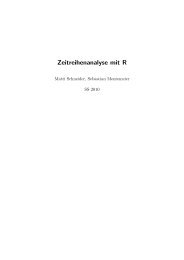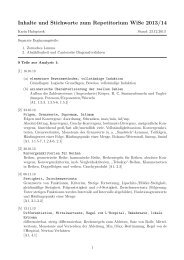Margulis Lemma
Margulis Lemma
Margulis Lemma
You also want an ePaper? Increase the reach of your titles
YUMPU automatically turns print PDFs into web optimized ePapers that Google loves.
STRUCTURE OF FUNDAMENTAL GROUPS 7<br />
Proof. We choose a measurable section j : B 1 (p) → B 1 (˜p), i.e. π(j(x)) = x for any<br />
x ∈ B 1 (p). Let T = j(B 1 (p)). Then we obviously have that diam(T ) ≤ 2 and<br />
∫ ∫<br />
− f = − ˜f.<br />
B 1(p)<br />
Let S be the union of g(T ) over all g ∈ π 1 (M) such that g(T ) ∩ B 1 (˜p) ≠ ∅. It’s<br />
obvious from the triangle inequality that S ⊂ B 3 (˜p). It is also clear that<br />
∫ ∫<br />
− f = − ˜f<br />
B 1(p)<br />
and B 1 (˜p) ⊂ S. Lastly, notice that by Bishop–Gromov relative volume comparison<br />
vol B 3 (˜p) ≤ C(n) vol B 1 (˜p) for some universal constant C(n). Since B 1 (˜p) ⊂ S ⊂<br />
B 3 (˜p), we also have vol B 3 (˜p) ≤ C(n) vol S and hence<br />
∫<br />
∫ ∫<br />
− ˜f ≤ C(n)− ˜f = C(n)− f.<br />
B 1(˜p)<br />
S<br />
T<br />
S<br />
B 1(p)<br />
It is easy to see that the above proof generalizes to an arbitrary cover of M.<br />
1.3. Equivariant Gromov–Hausdorff convergence. Let Γ i be a sequence of<br />
closed subgroups of the isometry groups of metric spaces X i and ˜p i ∈ X i . If<br />
(X i , ˜p i ) converges in the pointed Gromov–Hausdorff topology to (Y, ˜p ∞ ), then after<br />
passing to a subsequence one can find a closed subgroup G ⊂ Iso(Y ) such that<br />
(X i , Γ i , ˜p i ) → (Y, G, ˜p ∞ ) in the equivariant Gromov–Hausdorff topology. For details<br />
we refer the reader to [FY92].<br />
Definition 1.7. A sequence of subgroups Υ i ⊂ Γ i is called uniformly open, if there<br />
is some ε > 0 such that Υ i contains the set<br />
{<br />
g ∈ Γi | d(gq, q) < ε for all q ∈ B 1/ε (˜p i ) } for all i.<br />
Γ i is called uniformly discrete if {e} ⊂ Γ i is uniformly open. We say the sequence<br />
Υ i is boundedly generated if there is some R such that Υ i is generated by<br />
{g ∈ Υ i | d(g˜p i , ˜p i ) < R}.<br />
<strong>Lemma</strong> 1.8. Let Υ j i ⊂ Γ i be uniformly open with Υ j i → Υj ∞ ⊂ G, j = 1, 2.<br />
a) Υ 1 i ∩ Υ2 i is uniformly open and converges to Υ1 ∞ ∩ Υ 2 ∞.<br />
b) If g i ∈ Γ i converges to g ∞ ∈ G then g i Υ 1 i g−1 i is uniformly open and converges<br />
to g ∞ Υ 1 ∞g∞ −1 .<br />
c) Suppose in addition that Υ j i is boundedly generated, j = 1, 2. If Υ1 ∞ ∩ Υ 2 ∞<br />
has finite index H in Υ 1 ∞, then Υ 1 i ∩ Υ2 i has index H in Υ1 i for all large i.<br />
The proof is an easy exercise.<br />
Example 1 (Z l actions converging to a Z 2 -action.). Consider a 2-torus T 2 k<br />
given by<br />
a Riemannian product S 1 ×S 1 where each of the factors has length k. Put l = k 2 +1<br />
and let Z/lZ act on T 2 k by ( e 2πi<br />
k 2 k2πi )<br />
+1 , e k 2 +1 . In the equivariant Gromov–Hausdorff<br />
topology the action will converge (for k → ∞) to the standard Z 2 action on R 2 .<br />
One can, of course, define a similar sequence of actions on S 3 × S 3 but in this<br />
case the actions will not be uniformly cocompact.<br />
□


